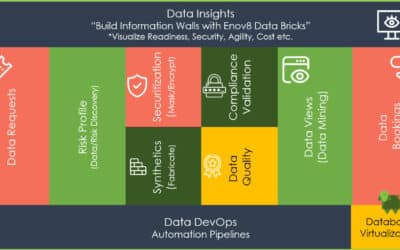
Reducing Storage Costs with Tiny Databases
OCT, 2023
by Andrew Walker.
Author Andrew Walker
Andrew Walker is a software architect with 10+ years of experience. Andrew is passionate about his craft, and he loves using his skills to design enterprise solutions for Enov8, in the areas of IT Environments, Release & Data Management.
In today’s data-driven landscape, the effective management of data storage in non-production environments holds unprecedented significance. However, the escalating costs associated with data storage cannot be overlooked. In this article, we will delve deep into the strategies and considerations that organizations can employ to optimize storage in these lower environments without incurring exorbitant expenses.
Enov8 Test Data Manager
*aka ‘Data Compliance Suite’
The Data Securitization and Test Data Management platform. DevSecOps your Test Data & Privacy Risks.
Understanding Lower Environments
Lower environments, comprising development, testing, and staging, are foundational components in the software development lifecycle. These environments serve as crucibles for ensuring that software applications function flawlessly post-deployment. Nevertheless, the intricacies of data management within these lower environments present formidable challenges, particularly in the realm of storage cost optimization.
The Cost Implications
The costs associated with data storage in lower environments can burgeon exponentially if left unchecked. Visualize the scenario wherein redundant data is stored across multiple testing environments or where obsolete data that serves no functional purpose continues to occupy valuable storage resources. The resulting financial burden can be staggering. For instance, consider a hypothetical scenario in which an organization’s production data experiences an annual growth rate of 10%. Without proactive optimization measures, the cascading effect on non-production environments could translate into an exponential surge in storage costs.
Major Contributors to High Storage Costs
Several factors act as catalysts, inflating storage costs within lower environments:
- Data Duplication: The practice of maintaining multiple copies of identical data across different lower environments, needlessly consuming storage capacity.
- Lack of Data Lifecycle Management: The absence of a systematic approach to oversee the entire lifecycle of data, from its creation to eventual deletion, contributes to storage inefficiency.
- Infrequent Data Purging: Retaining obsolete or irrelevant data beyond its useful lifespan, failing to systematically purge data that should no longer be retained.
- Over-provisioning: The over-allocation of storage resources beyond what is truly necessary for the operations within these lower environments.
Strategies to Reduce Storage Costs
a. Data Subsetting
Data subsetting is a prudent practice that involves the utilization of smaller, yet still pertinent, datasets tailored for specific testing scenarios. Instead of duplicating and storing the entire production database within lower environments, organizations can meticulously extract and retain only a subset of data that serves the precise testing requirements, thereby conserving valuable storage space.
b. Database Virtualization
Database virtualization represents an innovative approach whereby virtual representations of databases are established within non-production environments. Instead of housing full-fledged copies of databases, this approach advocates the maintenance of lightweight versions that fulfill the same functional purposes. This not only leads to significant savings in storage space but also enhances data agility and flexibility.
c. Governance and Housekeeping
Data governance assumes a central role, transcending mere compliance concerns and extending into the realm of operational efficiency. Robust governance policies, when enacted, ensure that data storage remains perpetually optimized. Regular housekeeping activities, including scheduled data purges and archiving of historical data, act as guardians, ensuring that only relevant and current data occupies precious storage resources.
The Role of Automation in Storage Management
In an era where operational efficiency is paramount, automation emerges as the indisputable champion. The automation of data lifecycle management processes, particularly those associated with subsetting, virtualization, and governance, empowers organizations to secure storage optimization. Automation not only contributes to cost reduction but also streamlines data management, making data readily available whenever needed.
Data Privacy and Compliance
In the contemporary landscape, characterized by stringent regulations like GDPR, PCI, and HIPAA, data privacy stands as an imperative concern. This is particularly significant within lower environments, where data is frequently accessed and manipulated during the development and testing phases. Thus, it is incumbent upon organizations to ensure that sensitive data is meticulously masked or anonymized. This dual-pronged approach not only maintains regulatory compliance but also fosters trust among stakeholders.
Conclusion
The management of storage costs within lower environments necessitates a delicate equilibrium between operational efficiency and effectiveness. While the availability of sufficient data for testing and development remains non-negotiable, it is equally imperative to uphold the principles of storage optimization. By prioritizing and implementing strategies such as data subsetting, database virtualization, and the establishment of robust governance frameworks, organizations can successfully strike this balance. In doing so, they ensure seamless operations without succumbing to unnecessary expenses, thereby fortifying their competitive edge in today’s data-driven landscape.
Relevant Articles
8 DevOps Anti-Patterns to Avoid
It’s the normal case with software buzzwords that people focus so much on what something is that they forget what it is not. DevOps is no exception. To truly embrace DevOps and cherish what it is, it’s important to comprehend what it isn’t. A plethora...
An Introduction to Application Rationalization
In today's fast-paced digital landscape, organizations often find themselves grappling with a sprawling array of applications. While these applications are crucial for various business operations, the lack of a structured approach to managing them can lead to...
What Makes a Great Test Data Management Tool
What Makes a Great Test Data Management Tool? In today's fast-paced IT landscape, having a robust Test Data Management (TDM) tool is crucial for ensuring quality, compliance, and efficiency in software development and testing. At Enov8, we pride ourselves on providing...
The Top Application Portfolio Management Tools
Managing an application portfolio is essential for organizations aiming to optimize their IT operations, reduce costs, and enhance overall efficiency. Application Portfolio Management (APM) tools are designed to help organizations achieve these goals by providing a...
What Is a Test Data Manager?
Testing is a critical aspect of software development, and it requires the use of appropriate test data to ensure that the software performs optimally. Test data management (TDM) is the process of creating, storing, and managing test data to ensure its quality,...
Sprint Scheduling: A Guide to Your Agile Calendar
Agile sprints can be a powerful, productive and collaborative event if managed properly. However, when neglected or set up incorrectly they risk becoming chaotic and inefficient. Crafting an effective schedule for your sprint is essential to ensure the success of your...










